LETTRE DE SAMOS
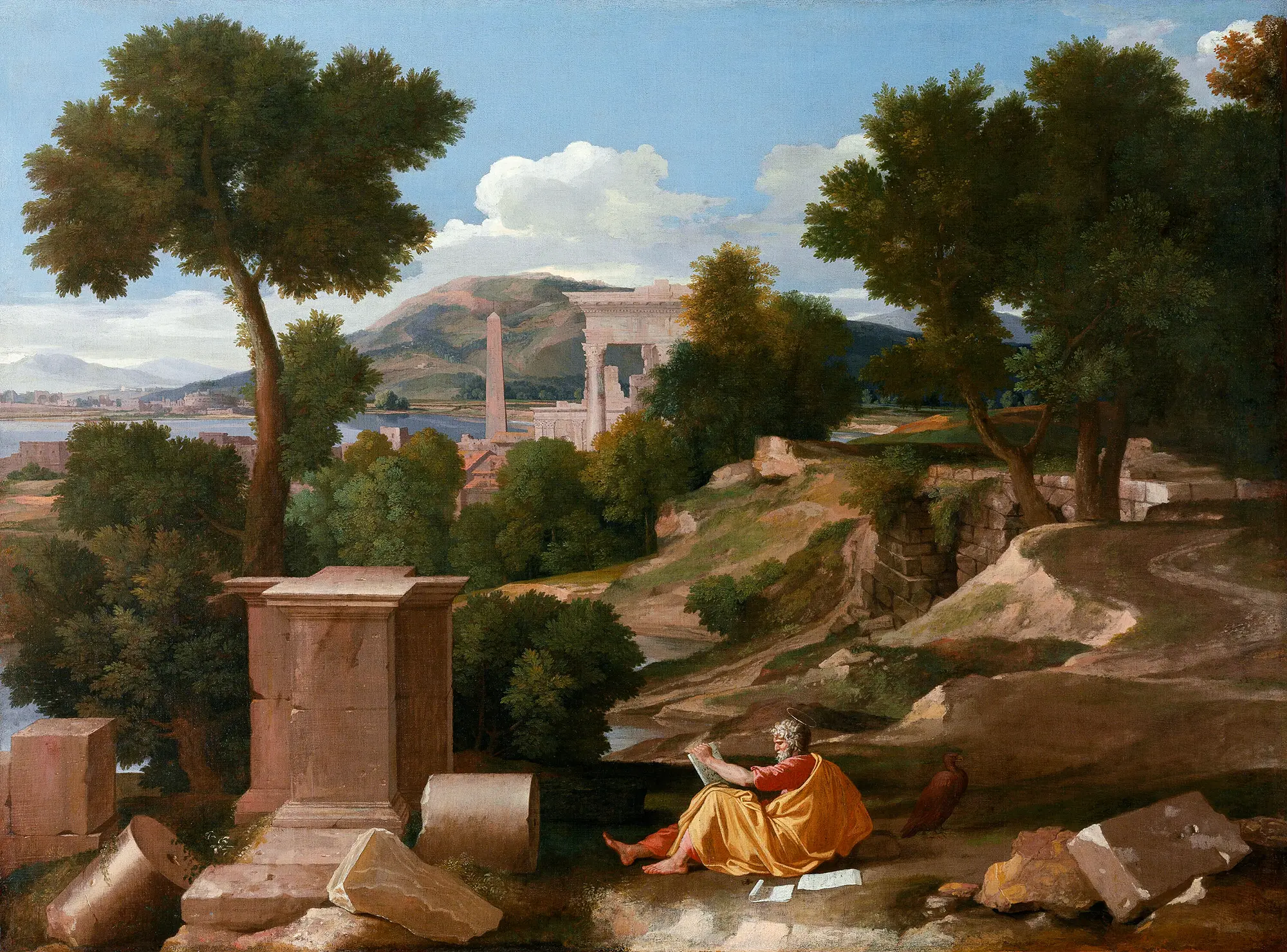
“Not what we have, but what we enjoy, constitutes our abundance.” — Epicurus
Samos, 29 August 2025
My dear reader,
I write to you from the small Greek island of Samos, set to the east of Greece in the northern Aegean Sea, just off the coast of Turkey. It is a little past seven, and as I put these words down, the sun is only just beginning to rise.
The wind is strong here, as it always is—this dry northern wind called the Meltemi, or the Etesians in ancient Greek. It shapes the days, filling the air with a crystalline clarity and making the sea seem to sing. Samos is one of those islands where, in the morning, sea and sky dissolve into a single, endless blue. And at dusk, the sky fades into rose before surrendering to night, leaving us spellbound beneath a bed of shining stars.
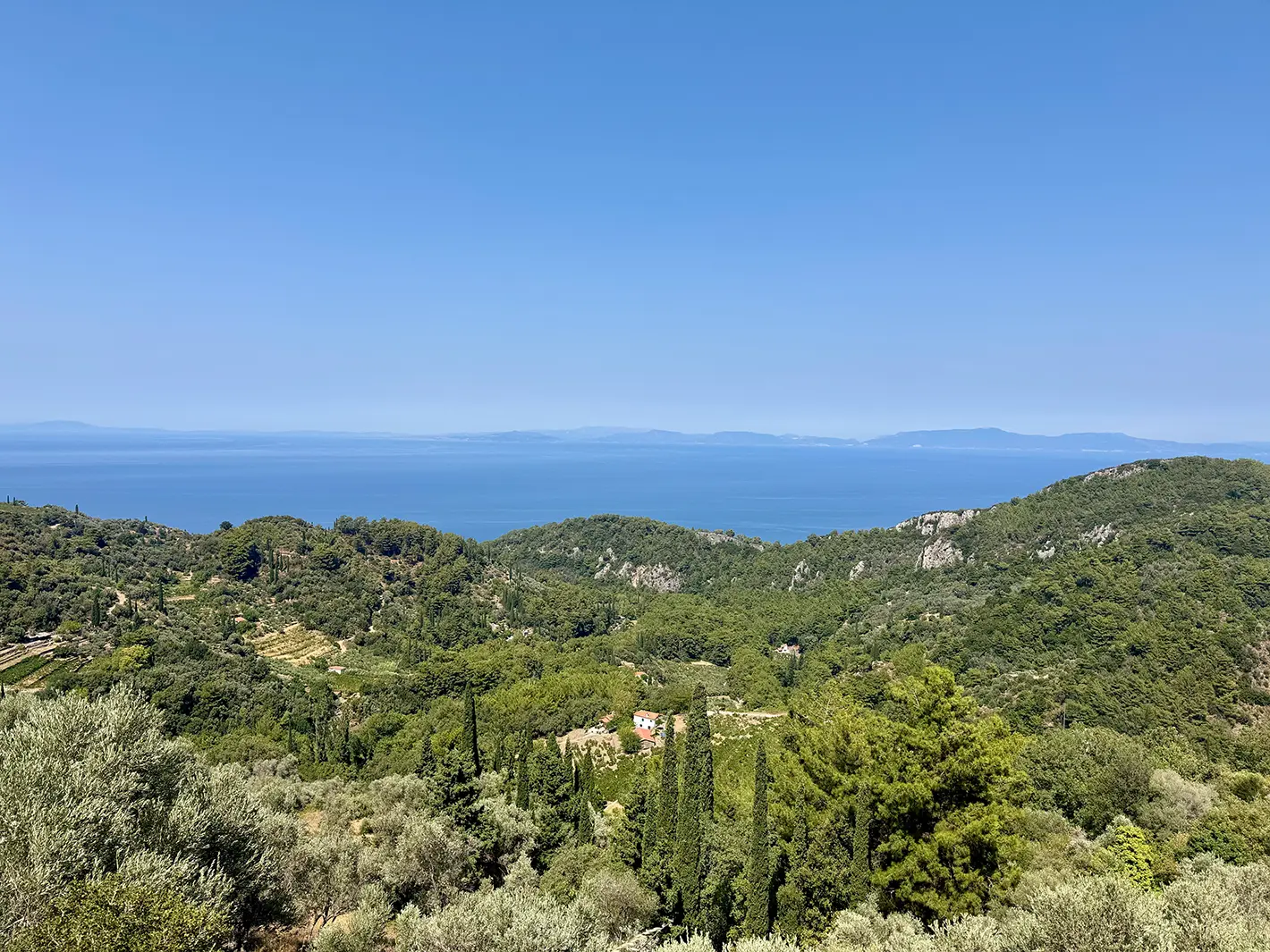
Here is Greece in its wildest form: narrow paths bordered by endless olive groves (I believe I have never seen so many in my life), different kinds of pines, fruit trees—fig, prickly pear, lemon, almond—together with herbs by the roadside and flowers that seem to bloom only beneath the Mediterranean sun.
You will come across traditional fishing harbors, and small seaside villages—some more frequented by visitors, like Pythagoreion (the great fortified port of Samos in the 5th century BC, and birthplace of the renowned philosopher and mathematician Pythagoras) or Kokkari. And then, further inland or high in the mountains, villages such as Manolates or Vourliotes, where being a visitor—especially a French one—still carries a touch of exoticism for the locals.
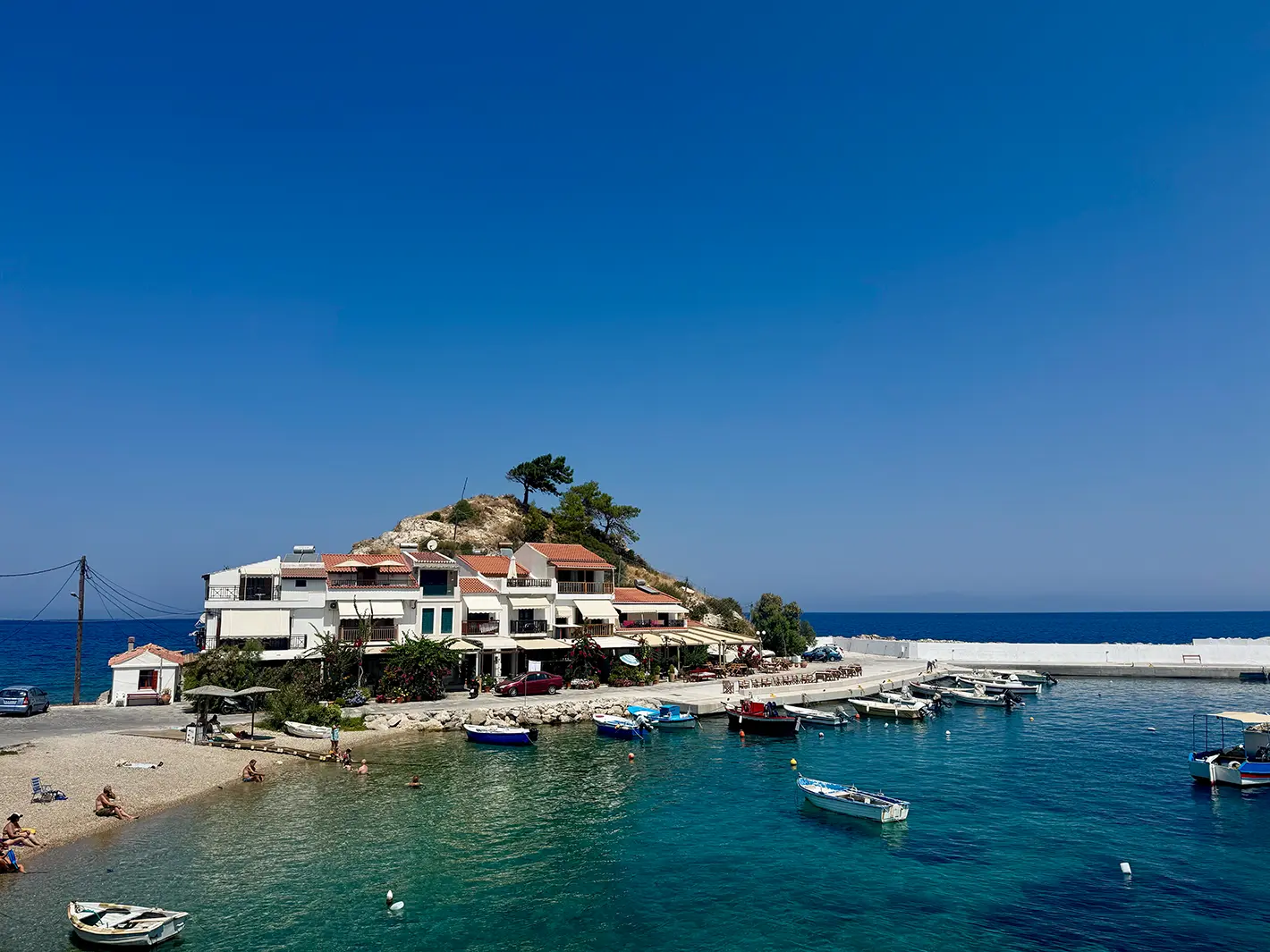
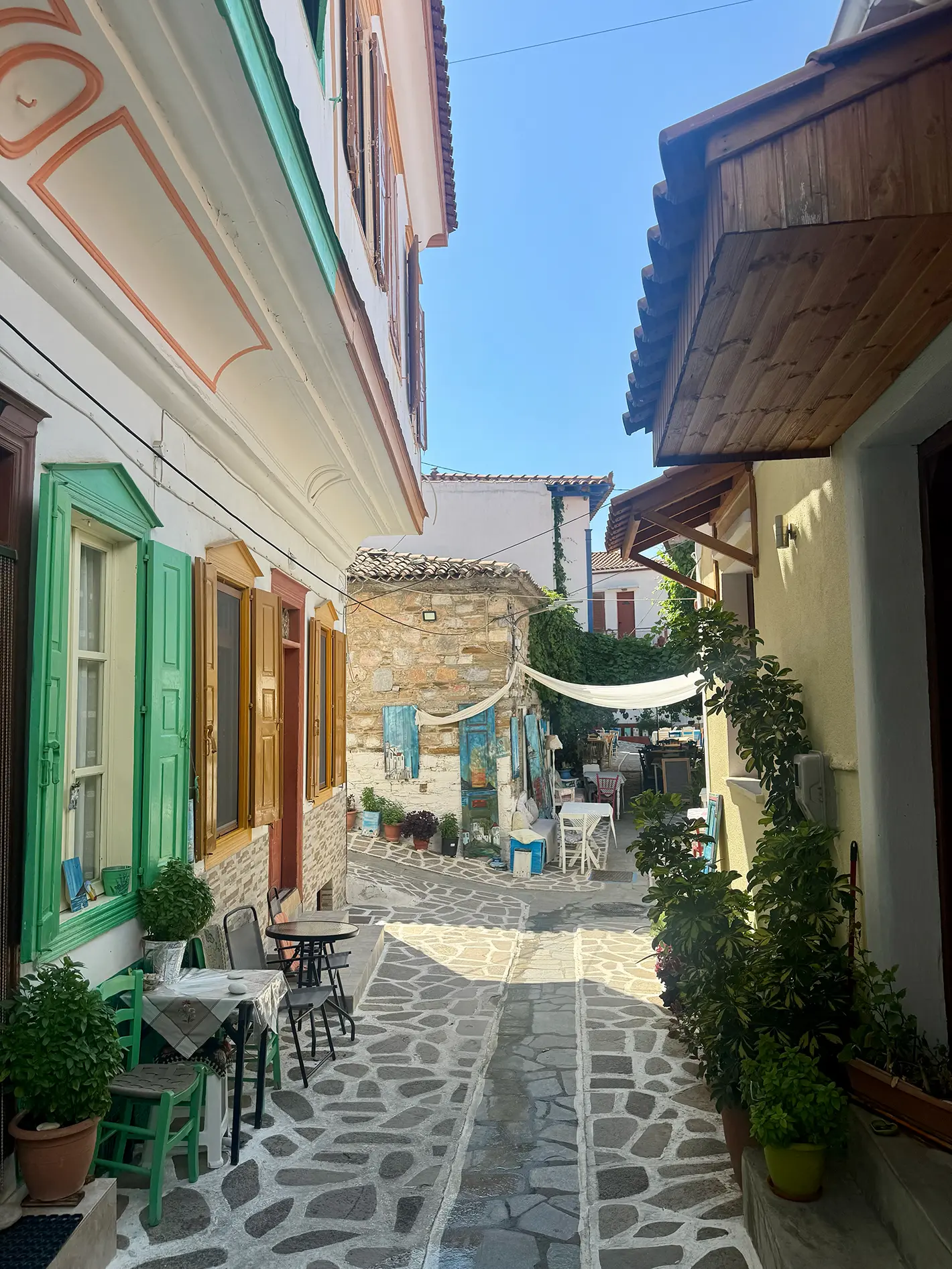
As you wander, you will always find a taverna serving Greek food in the purest tradition. Some don’t even offer a menu: the owner simply tells you what you will eat. Others are modest, almost hidden, yet open onto breathtaking views—over valleys, over the sea, which is never far and always part of the landscape.
Some are tucked deep within a village of only a few souls, where you linger over the island’s simple sweetness in the shade of a great tree, its branches propped up by wooden beams. At times, you may find yourself lunching beneath a trellis of vines, the clusters of ripe grapes hanging low above your head or your plate, so close you could pluck them with your hand—like a gift the island offers you.
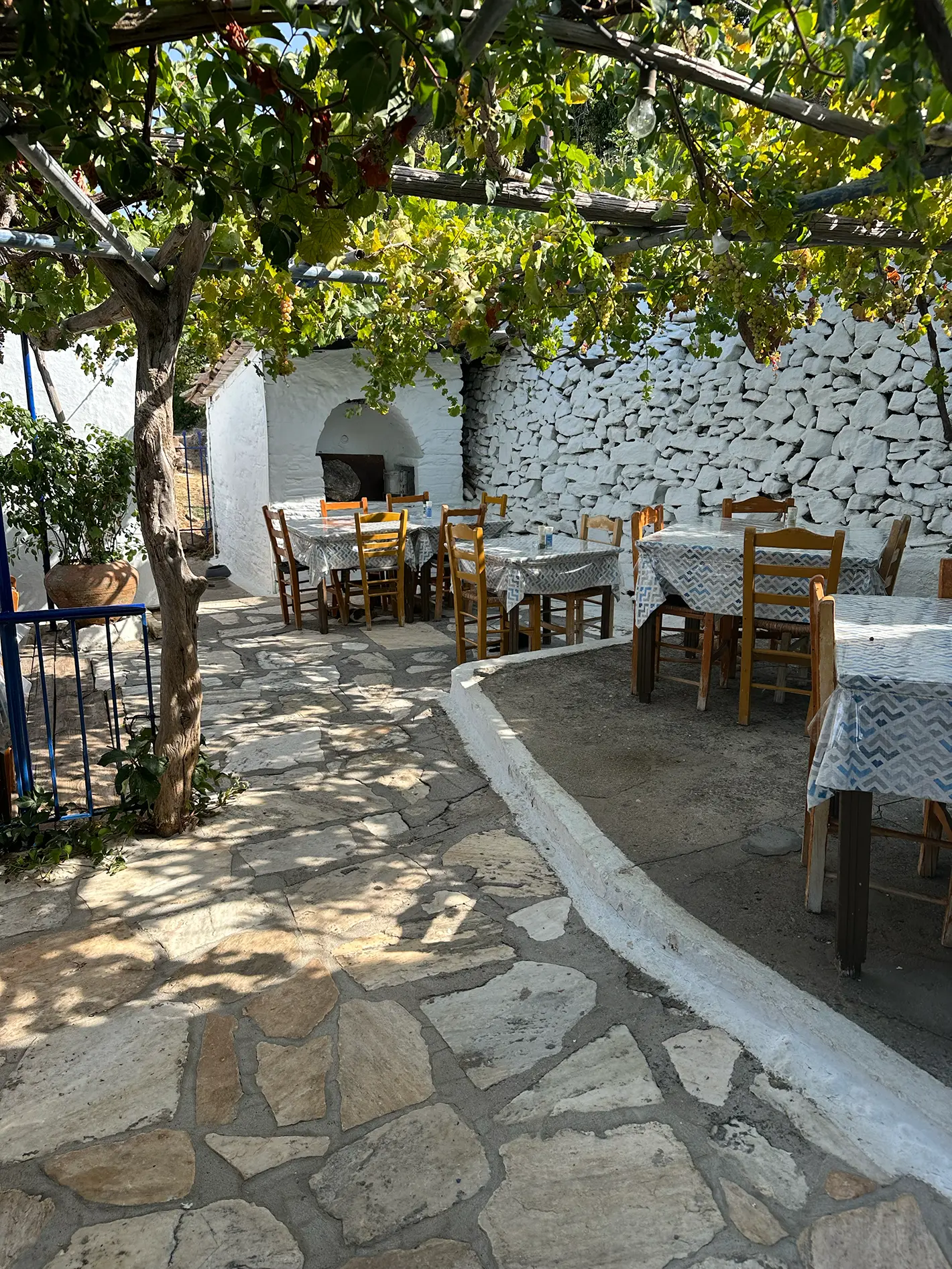
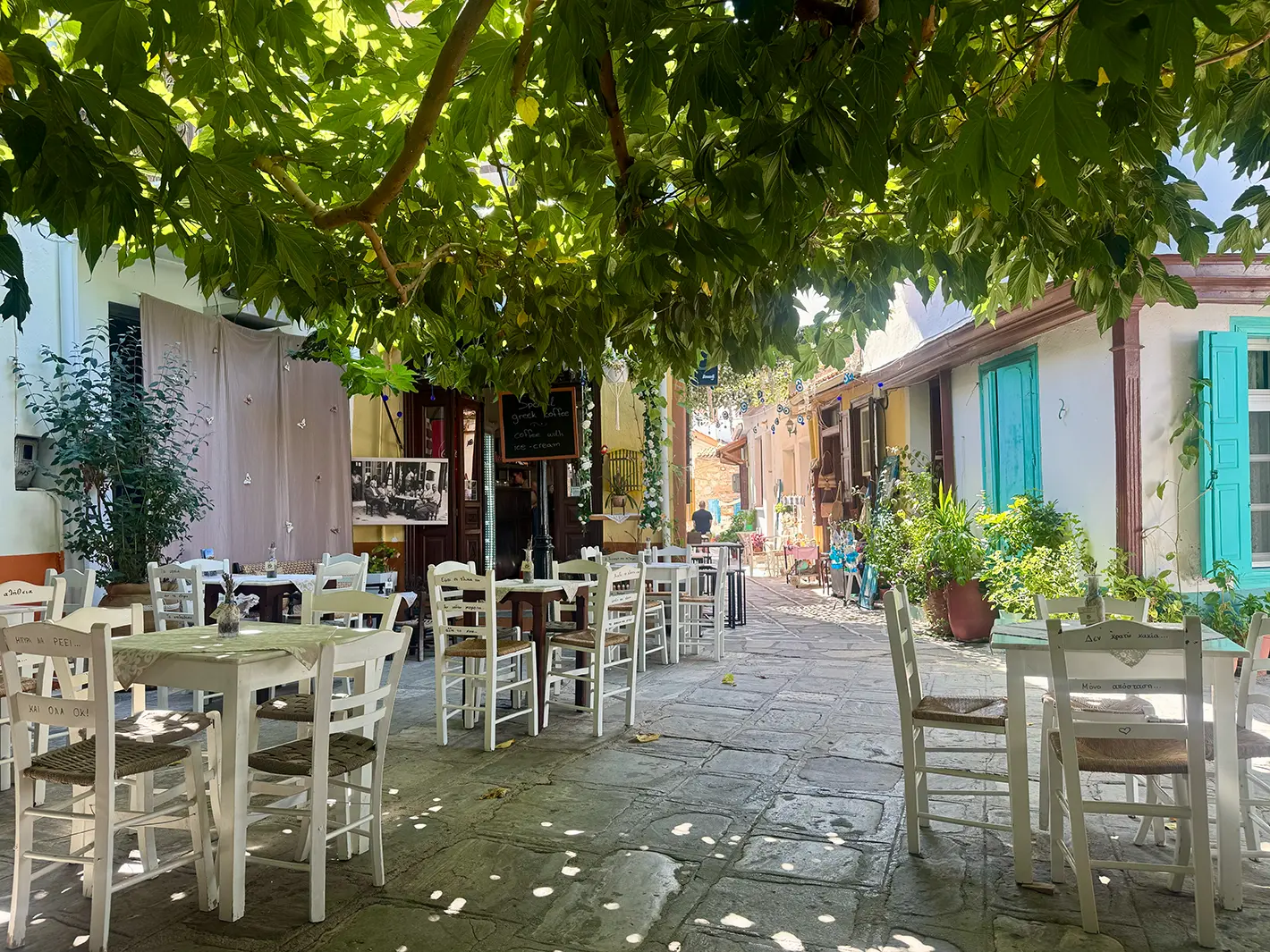
Here, the soil is fertile, and everything you taste carries a delicious sweetness: the Samos Vin Doux, golden as honey and so soft on the palate that it seems to hold the flowers and ripe fruits of summer (it has become my favorite wine), and the traditional dishes touched with the island’s honey.
Did I mention that, in Greek mythology, Samos is said to be the birthplace of Hera—the goddess of women, marriage, family, motherhood, and the hearth? On the island you can still see the ruins of the Temple of Hera (Heraion), first built in the 8th century BC and dedicated to the goddess. Legend has it that it was here, on Samos, that the mythical couple Zeus and Hera honeymooned—for no less than three hundred years.
Archaeological sites are woven into the landscape, like the Roman Baths just outside the entrance to Pythagoreion, dating from the 2nd century AD (over eighteen hundred years ago!). It is always moving, almost mystical, to stand before these stones—knowing they were here long before us, and will remain long after we are gone.
It was, in truth, everything we had been searching for this summer: a return to that authentic Mediterranean magic, which so often fades beneath the weight of mass tourism. The sun, the sea, the scent of pines and blossoming flowers, with nothing but the song of cicadas and crickets as music.
And I found myself wondering about the meaning of travel—of holidays, of journeys—or perhaps even something more philosophical (after all, Samos is known as the birthplace of the philosopher Epicurus, and the island must surely have played its part in shaping his thought). What is it that we truly bring back from our travels? What do we carry with us, or even learn from them?
Perhaps we have lost, in part, the very sense of why we travel. Beyond the simple pleasures—the sun, the beach, the sea, leisure—and beyond visiting the most well-known attractions (where we often find ourselves gathered all in the same place, at the same moment), might not our journeys also be a way to learn something deeper about ourselves, and about others? To open us, perhaps, to new perspectives and new horizons?
It is a question I leave open here, unresolved. I do not pretend to have the answer—though, as you will have guessed, the question is in itself a little rhetorical.
As for me, from this journey I will bring back, first of all, a few recipes—typically Greek or Cretan—that I discovered and savored here on the island. Simple, flavorful dishes that I will gladly make again at home, and that I wanted to share with you (recreated from memory, in my own way):
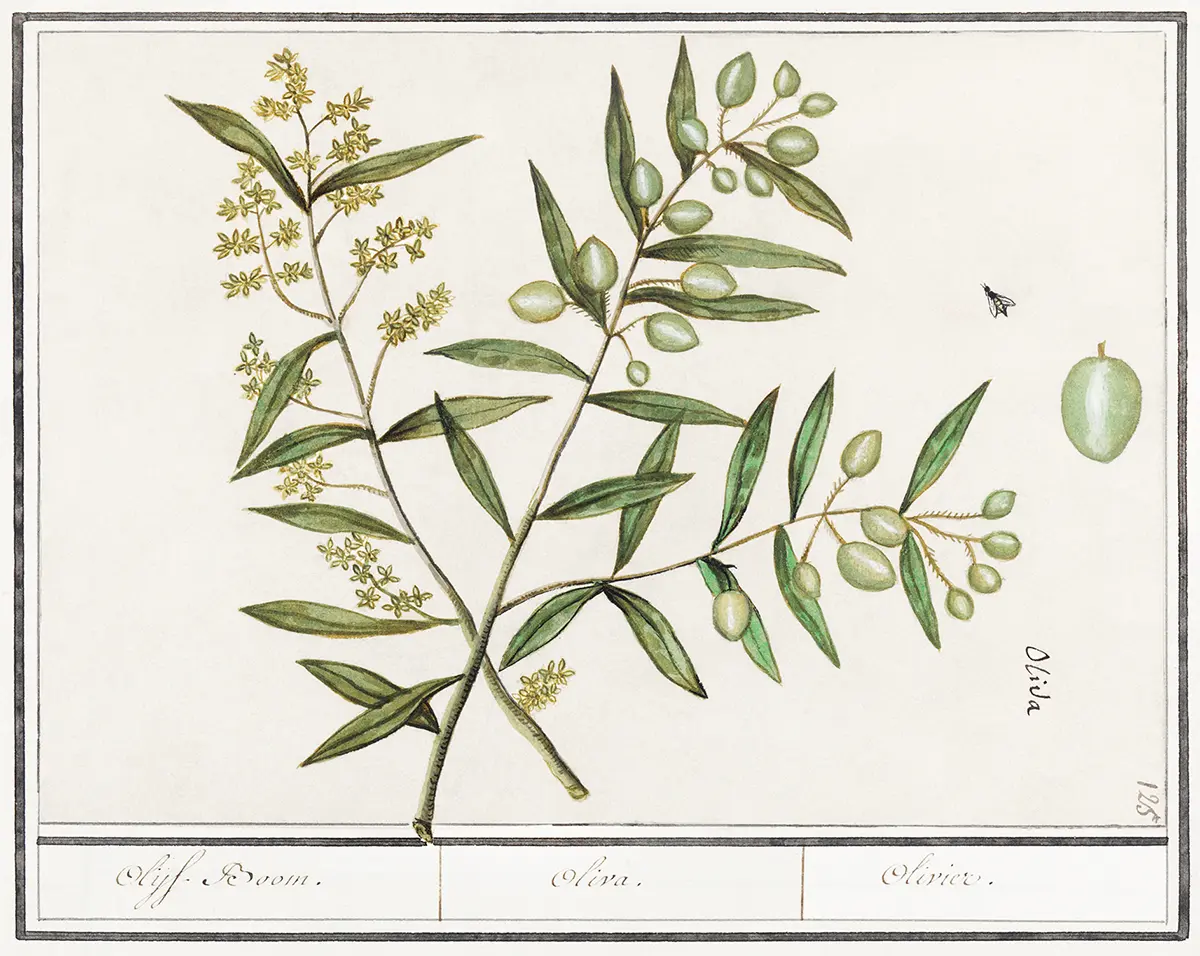
Menu
Beetroots & Greek Yogurt
Slice a few beetroots, already cooked, into pieces. In a bowl, add one clove of garlic, finely chopped, a spoonful of honey, a few spoonfuls of Greek yogurt, some crushed walnuts, and feta cut into small cubes. Finish with a drizzle of olive oil and a splash of red wine vinegar. Mix gently and serve well chilled.
·
Dakos
Lightly moisten a few Cretan barley rusks under running water, just enough to soften them without losing their crunch. Arrange them on a plate and drizzle generously with olive oil. Spoon over grated ripe tomatoes, season with sea salt, crumble feta or mizithra on top, and finish with a scattering of dried oregano and, if you like, a few black olives. Serve immediately, with a glass of chilled white wine.
·
Saganaki Cheese
Slice kefalotyri, graviera, or halloumi into thick pieces and pat them dry. Dust lightly with flour, shaking off any excess. In a skillet, warm olive oil until shimmering, then fry the cheese until golden and crisp on both sides. Serve at once, with lemon wedges to squeeze over while it is still hot.
·
Skordalia
Boil a few potatoes until tender, then mash them until smooth. In a mortar, crush several garlic cloves with a little sea salt to form a paste, and fold this into the potatoes. Slowly whisk in olive oil, alternating with splashes of red wine vinegar, until the mixture becomes creamy. Adjust the seasoning and serve at room temperature, with warm bread or vegetables.
·
Kopanisti
Mash feta with a fork until crumbly, then add a spoonful of Greek yogurt, a drizzle of olive oil, a dash of red wine vinegar, and a pinch of chili or chili flakes. Blend until smooth and creamy. Finish with freshly ground black pepper and a thread of olive oil. Serve with warm pita or crisp vegetables.
·
Sfakiani Pie
Prepare a soft dough with flour (200g), olive oil (2 tbsp), a pinch of salt, and enough lukewarm water (100ml) to bring it together. Knead gently, then let rest for half an hour. Roll into thin rounds, place a spoonful of soft cheese (mizithra or ricotta works well) in the center, fold and flatten into a delicate pie. Cook on a dry skillet for two to three minutes per side, until lightly golden. Serve warm, drizzled with thyme honey.
·
But beyond tasting the pleasures of Epicurus, the island of Samos has taught me to see the invisible, to listen to the unspeakable, and to lend objects a kind of supernatural power. There is magic in the air here. Everyone knows it, though no one will tell you. Greek culture is steeped in mysteries, in mythologies, in stories that unsettle the Cartesian mind, tease the curious one, and at times even disorient the most rational.
Houses, tavernas, and small shops are protected against the evil eye by the blue eye—called Mataki or Matiasma—a popular belief that an envious glance can bring harm. You see them everywhere: hung on the walls of shops and houses, or worn as talismans, turned into jewelry. Step inside, and in some quiet corner you may find a small place of devotion: a carved wooden table, golden icons catching the light, burning candles, ex-votos, a cross, and a small book of prayers, its pages worn and softened by the hands of generations. A place that marks the presence of God within the home, and serves for daily prayer and veneration.
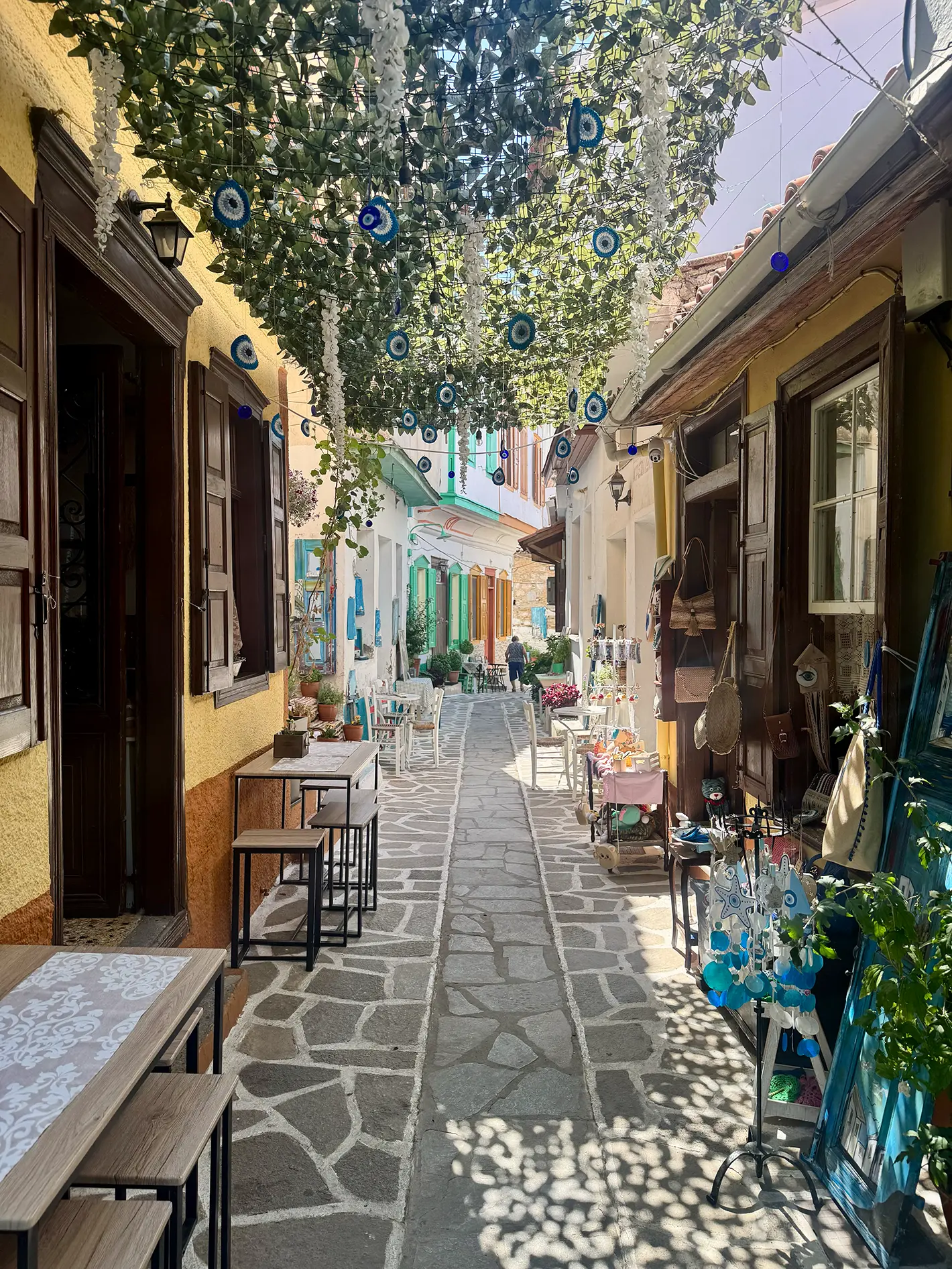
Along the roadside, if you take care not to drive too fast, you will notice miniature shrines—kandylakia—built by locals to commemorate a loved one lost in an accident, to give thanks for a miracle, or to mark a significant event such as a birth or a wedding. If you pause to look closely, you will see inside an icon, a photograph, a rosary, an oil lamp still burning at night—the lone light flickering in the distance along a winding mountain road in the dark.
On the island, Chronos compels you to slow down. Along the way, you may find yourself stopped on the road by an indifferent shepherd and his herd of goats, his dogs making it clear that you will have to wait before passing. Or you may pause on a bench carved from stone, to take in the panorama offered as a gift by Artemis, Pan, or Gaia.
After a long, winding path through the mountains, just beyond a bend, you may suddenly come upon a monastery rising proudly, its dome painted in azure blue, as if to dissolve into the sky. And then, before night falls, you may arrive at the very top—in a village whose heart is no more than a single taverna, where the locals will look at you with quiet curiosity, for few travelers venture this far.
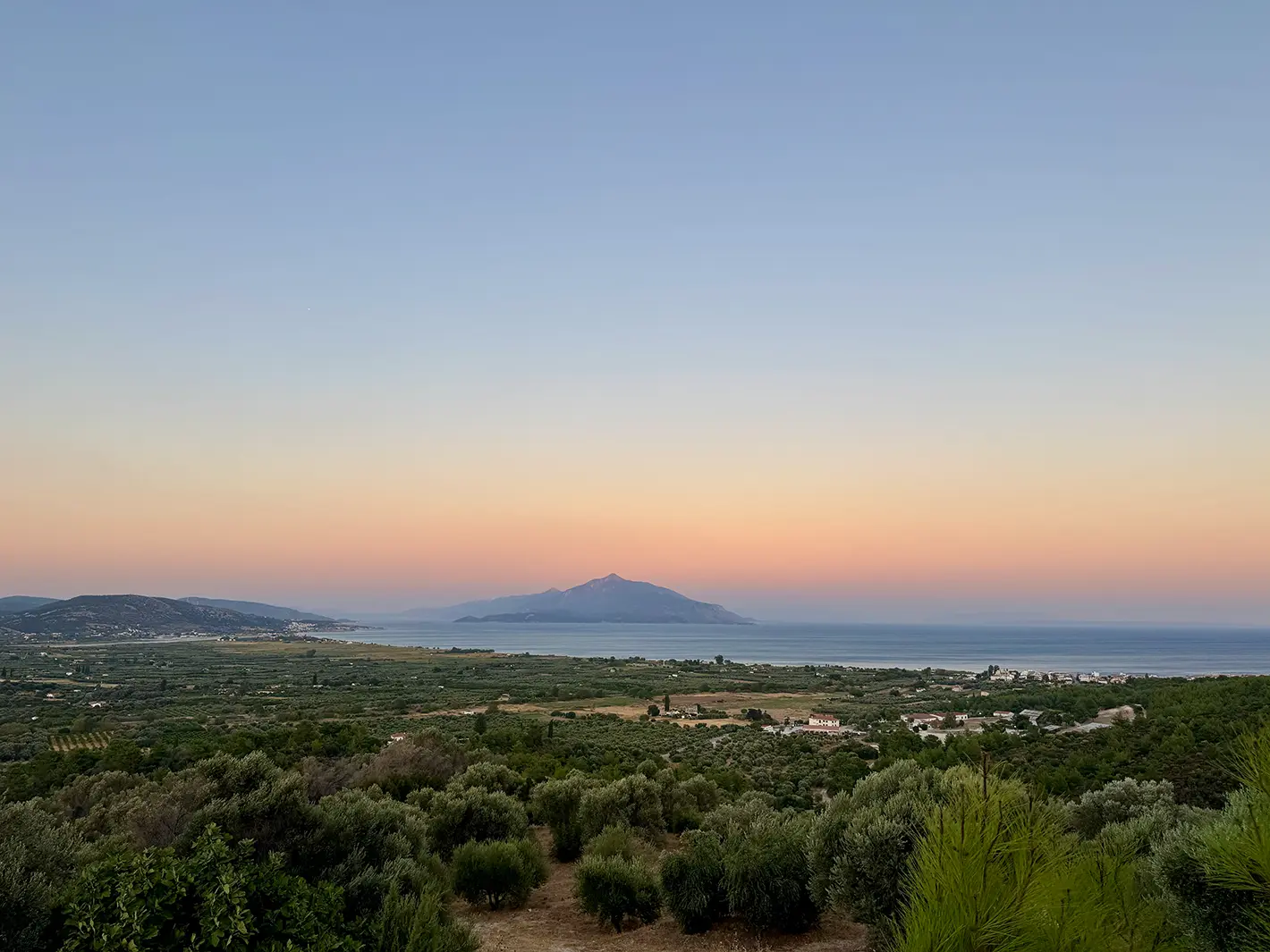
The sun has just risen, and already the warmth settles in. In the sky, swallows begin their graceful ballet, as if to greet the newborn day and to welcome Eos, the goddess of dawn. We are living our last day here, on this island that feels so far removed from the great cities one could almost believe we had left Europe behind.
Soon we will depart, our suitcases filled with the things one always brings back from a journey: a blue glass eye to watch over our home, a few dried herbs for infusions and remedies, a bottle of Vin Doux, local sweets, notebooks thick with sketches, recipes, and hurried notes.
But what Samos has truly given us cannot be packed away: the gift of a slower rhythm, the art of listening to silence and to cicadas, the magic of myths still alive in stone, the light of a dawn that seems eternal. These are dreams, stories, and that subtle inspiration that only an island touched by the gods can leave within us.
— Léonce.
P.S. If this letter has sparked in you the desire to explore Greece and perhaps to set foot on the island of Samos, I’ve gathered all my favorite addresses in Le Carnet d’Adresses. This poetic travel letter was written to travel further still, to be shared between friends and loved ones. And if your heart feels inclined, you can always say thank you by offering me a croissant. A small, tender gesture that helps me keep writing these letters to you.


